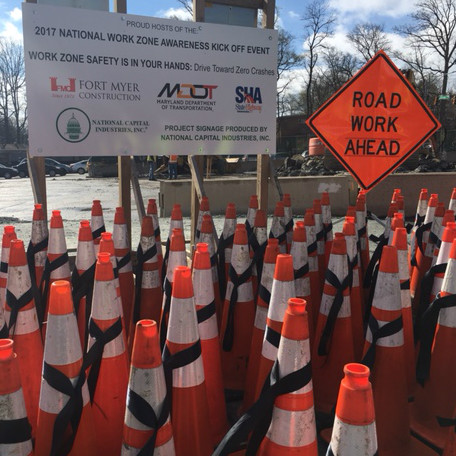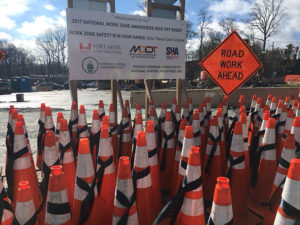
State Urges Drivers to Slow Down in Work Zones

Cones that will be used to direct traffic through the Georgia Avenue-Randolph Road interchange project | MDOT
Roadway workers risk their lives every day servicing the many highway construction projects in progress. But with increased traffic, fatal crashes are on the rise in work zones, according to the Maryland Department of Transportation.
Federal and state officials gathered at an active construction site at Georgia Avenue and Randolph Road on Tuesday to mark Work Zone Awareness Week. Gov. Larry Hogan declared the week, as well as April 5 as Go Orange – Roadway Worker Appreciation Day in Maryland.
Six people lost their lives in Maryland work zone crashes in 2016, the transportation department says. Nationally, 130 roadway workers were killed, the second highest amount in a decade.
Among the attendees at Tuesday’s event was work zone safety advocate Laurie Moser, whose husband, State Highway Administration employee Rick Moser died in a work zone-related crash. The event included the American Traffic Safety Services Association’s mobile National Work Zone Awareness Memorial. Moser’s name is featured on the memorial, as well as the names of workers, motorists and law enforcement officers killed in work zones crashes.
A complete listing of current roadway projects is included in E-Road Ready, the online brochure. For more information on Work Zone Safety Awareness, visit www.roads.maryland.gov and click on the work zone safety banner. Maryland drivers also can know before they go by calling 511 or visiting www.md511.org for live traffic updates, including construction delays and lane closures.

Michigan has the best freeway work zone speed limit rules. If needed for narrowed lanes, lane shifts, closed shoulders, etc. the normal 70 mph limit is reduced to 60. Then the signs say “45 Where Workers Present”. This forces drivers to actually look for workers that might be at risk and slow down near them. If all the workers are behind concrete barriers or way down in a wide median, the 45 does NOT apply. These rules facilitate much smoother traffic flows, effectively protect workers near the traveled lanes, prevent unnecessary delays when slower speeds are not required, AND prevent predatory speed traps for ticket profits in inactive work zones.
James C. Walker, National Motorists Association